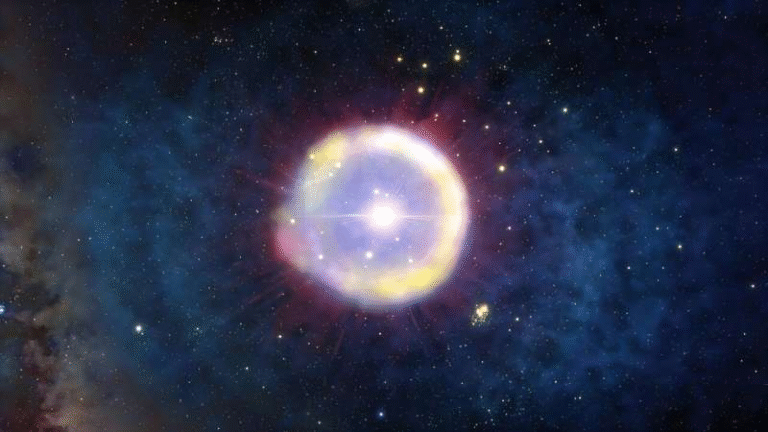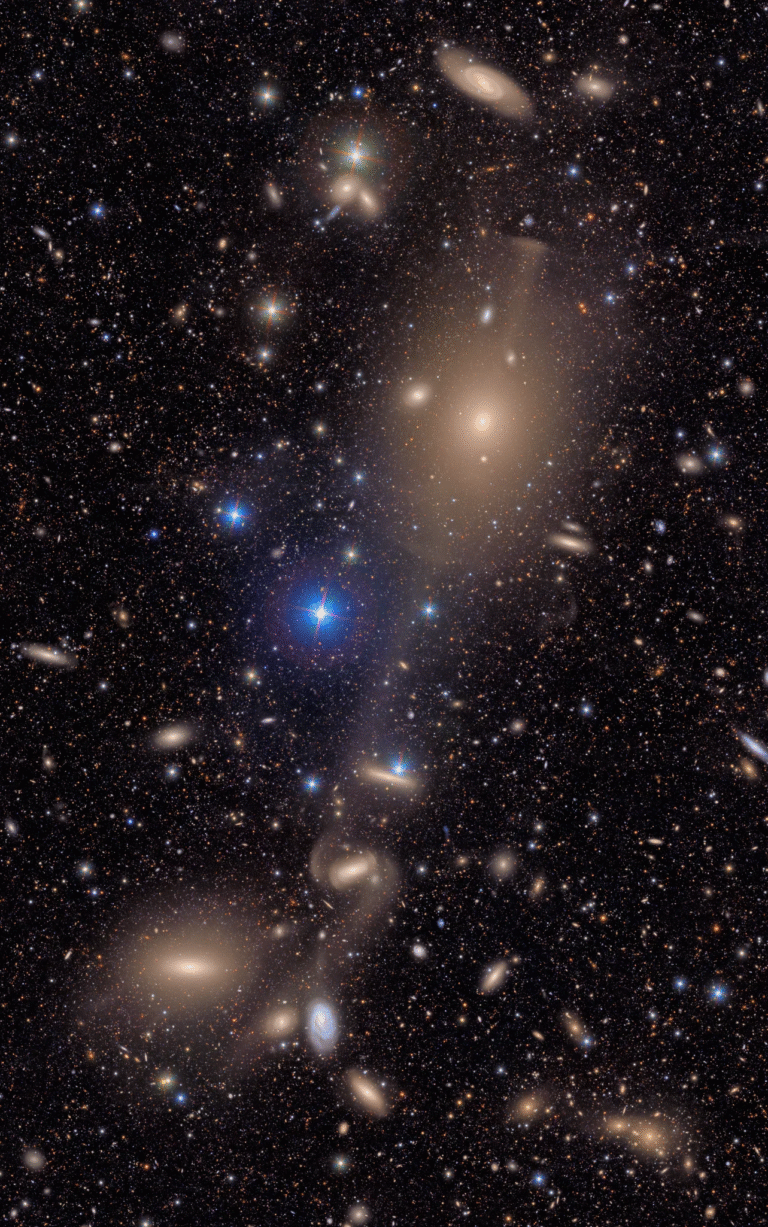New Theory Suggests Dark Matter Might Tint Light Red or Blue, Changing How We Search for It

For decades, scientists have believed that dark matter—the mysterious stuff that makes up most of the universe—does not interact with light at all. It was thought to be completely invisible, detectable only by its gravitational pull on galaxies and clusters. But a new theoretical study from the University of York challenges that long-held assumption in a bold and fascinating way.
According to the research, dark matter might slightly change the color of light as it passes through regions filled with it—causing a faint red or blue tint. This subtle shift, if confirmed, could become a new tool for astronomers to map and study dark matter across the cosmos.
The paper, titled “Dark matter: red or blue?”, was published in Physics Letters B in late September 2025 and also appears on arXiv. It was authored by A. Acar, C. Isaacson, M. Bashkanov, and D. P. Watts from the University of York’s School of Physics, Engineering and Technology.
Let’s break down what the researchers found, how they came up with this theory, and why it could change how we look for one of the universe’s greatest mysteries.
The Idea: Dark Matter Might Not Be Completely Invisible
Until now, the assumption has been simple: dark matter doesn’t interact with light. Photons (particles of light) pass through dark matter without noticing it. That’s why telescopes can’t “see” dark matter directly. Scientists detect it only by measuring its gravitational effects, such as how it bends light from distant galaxies (a phenomenon called gravitational lensing) or how it helps hold galaxies together that otherwise should fly apart.
But the new study proposes that dark matter might, in fact, leave behind a detectable color fingerprint—a change so small that it has gone unnoticed so far.
The researchers suggest that even if dark matter doesn’t interact directly with light, it could still influence photons indirectly through chains of particle interactions. They compared it to the “six degrees of separation” concept—how any two people on Earth are connected through just a few acquaintances. In a similar way, dark matter could be linked to light through a few “particle intermediaries.”
For example, if dark matter is made of Weakly Interacting Massive Particles (WIMPs)—a long-standing theoretical candidate—it could interact with photons through intermediate particles like the Higgs boson or the top quark. These indirect connections could cause tiny color shifts when light travels through dark matter-dense regions.
The Physics Behind the Color Shift
The York researchers built detailed theoretical models to see what might happen when photons pass near or through dark matter particles. They calculated scattering cross-sections—the probabilities that photons could scatter off dark matter via intermediate processes—and looked at two main scenarios:
- Dark Matter with Weak Interactions (WIMP-like)
In this case, dark matter interacts weakly with known particles in the Standard Model of physics. Their calculations show that higher-energy (bluer) photons are scattered more than lower-energy (redder) ones. So, light passing through such regions would lose more of its blue component and appear slightly reddened—a subtle red tint effect. - Dark Matter with Only Gravitational Interactions
If dark matter interacts only through gravity (not the weak or strong nuclear forces), the opposite effect might occur. Light could gain a faint blue tint under certain conditions because of the gravitational influence on photon scattering.
In other words, depending on how dark matter interacts, light passing through it could become either slightly redder or bluer. That’s why the study’s title calls it “red or blue.”
The researchers even calculated that this kind of scattering might create polarization effects, changing the orientation of light waves. These polarization changes might be easier to detect than color changes because they’re less likely to be confused with other astrophysical effects like dust.
What the Numbers Say
The team didn’t just theorize qualitatively—they ran the math. They modeled photon–dark matter interactions for photon energies of 1 GeV, 50 GeV, 500 GeV, and 800 GeV (extremely high-energy light such as gamma rays) interacting with dark matter particles of about 1 TeV (teraelectronvolt) in mass.
They found that in the WIMP case, the scattering tends to happen at larger angles—meaning photons are more likely to bounce off in different directions—while in the gravitational case, the scattering is more forward-focused. These angular differences contribute to how the tint might appear.
One of their major quantitative results is an upper limit on dark matter mass for the gravitational scenario:
Mχ < 5.0 × 10¹⁹ GeV.
That’s incredibly massive—billions of times heavier than a proton—but still within some theoretical models for so-called “WIMPzilla” or ultra-heavy dark matter particles.
They also found that, in practice, polarization measurements might be more sensitive than direct color observations. The color change is expected to be tiny, possibly beyond the reach of current instruments. However, the next generation of space telescopes might just be able to measure it.
How Could We Detect This Effect?
The authors suggest that if their theory is correct, astronomers might look for this subtle tint in light from distant galaxies or quasars that passes through regions dense with dark matter, such as galaxy clusters or the halos of large galaxies.
By comparing the colors and polarizations of light from these regions with those from areas with less dark matter, scientists could test whether dark matter is influencing light in measurable ways.
This could open up a completely new method for studying dark matter—one that relies on photons rather than particle collisions or gravitational effects. It might even help narrow down the search for what dark matter actually is.
Currently, many large-scale experiments—like those searching for WIMPs, axions, or dark photons—cost billions of dollars and involve massive underground detectors or high-energy accelerators. If astronomers can detect color shifts caused by dark matter instead, it might make the hunt for dark matter much more efficient.
Why This Matters
Understanding dark matter is one of the biggest unsolved problems in modern physics. Scientists know it makes up about 85% of all matter in the universe, but so far, no one knows what it’s made of.
We can’t see it, touch it, or detect it directly. All we know is that it exerts gravity, holding galaxies together and shaping cosmic structures. Without it, the universe as we know it wouldn’t look anything like it does today.
That’s why this new study is so interesting. It offers a new window—literally—into dark matter. If light really does get slightly tinted when passing through dark matter, that gives us a new observational signature to look for.
And even if the effect turns out to be extremely small, the calculations still help rule out certain types of dark matter and refine the search. Every new constraint helps narrow down what dark matter could or could not be.
Challenges and Caveats
As exciting as this theory sounds, it’s important to be realistic. The predicted color shift is incredibly small—far smaller than what most telescopes can currently detect.
Moreover, the universe is already full of things that can change the color of light, such as:
- Interstellar dust, which reddens starlight.
- Gas scattering, which can alter spectra.
- Gravitational redshift, where light loses energy as it climbs out of gravitational wells.
Distinguishing a tiny dark matter–related tint from all these other effects will be extremely challenging. The authors themselves emphasize that this is theoretical work for now. There’s no direct observation yet.
However, as telescope technology advances—especially with upcoming missions that can measure light spectra and polarization with extreme precision—this might change.
Future observatories like the European Extremely Large Telescope (E-ELT) or the Nancy Grace Roman Space Telescope could, in principle, test this hypothesis.
A Bit More About Dark Matter
Since the idea of “colored” dark matter might sound strange, it’s worth recalling what we know (and don’t know) about this cosmic mystery.
Dark matter was first proposed to explain why galaxies rotate the way they do. When astronomers measured how fast stars orbit their galaxies, they found that there wasn’t enough visible matter (stars, gas, dust) to keep them from flying apart. Something unseen—dark matter—was providing the missing gravitational glue.
Over the years, scientists have come up with many possible candidates:
- WIMPs (Weakly Interacting Massive Particles) – heavy particles that interact via the weak nuclear force.
- Axions – ultralight particles that could behave like a field filling space.
- Sterile neutrinos – heavier cousins of regular neutrinos that rarely interact.
- Dark photons – hypothetical carriers of a dark electromagnetic force.
Despite decades of experiments, none of these have been conclusively detected. That’s why new ideas—like looking for color or polarization signatures in light—are valuable. They expand the range of ways we might finally “see” dark matter.
The Broader Picture
This study is a reminder that dark matter might not be as dark as we think. Even if it’s invisible to our eyes, it could still leave faint fingerprints on the light passing through it.
By exploring these subtle effects, physicists might uncover entirely new connections between light, gravity, and the unseen structure of the universe.
While it’s too early to say if this theory will hold up under observational scrutiny, it’s exactly this kind of creative theoretical work that drives science forward. Every new hypothesis helps refine our understanding of the cosmos.
The University of York researchers have opened up a new possibility—that color and polarization might hold the key to the universe’s invisible matter.
If proven true, we may one day look up at the sky and realize that the colors of the universe have been whispering secrets about dark matter all along.
Reference:
Dark matter: red or blue? — Physics Letters B (2025)





